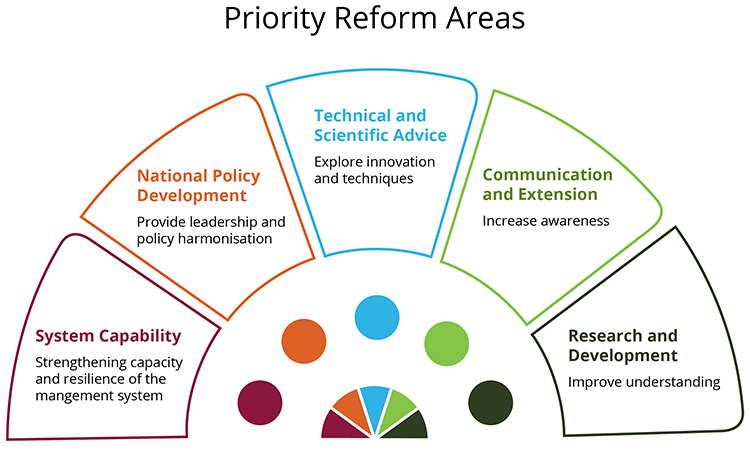On 19 November 2018, the Australian government announced the Smart Fruit Fly Management measure to strengthen and modernise fruit fly management across Australia.
The focus of the work under the measure is to:
- strengthen the capability, capacity and resilience of Australia’s fruit fly management system
- facilitate the national harmonisation of fruit fly management activities with international standards
- underpin, extend knowledge and support activities with technical and scientific advice, including research activities
- ensure all participants are aware of their shared responsibility for strengthening the Australian fruit fly management system, while maintaining and improving market access with valued international trading partners.
The Intergovernmental Agreement
The Australian, state and territory governments have ratified the Intergovernmental Agreement on Strengthening Australia’s Fruit Fly Management System.
By ratifying the Agreement, all Australian governments recognise that fruit fly management is a responsibility shared by all Australians. Cooperation with local government, industry and the community is essential for creating and maintaining a strong national fruit fly management system.
The Agreement outlines the roles, responsibilities, commitments and expectations of all parties to collaboratively strengthen and maintain Australia’s fruit fly management system. The Agreement also outlines priority reform areas.

Systems capability
The Systems Capability component will strengthen the capability, capacity and resilience of Australia’s fruit fly management system; it is being supported and maintained through a rigorous assurance framework.
This component includes work on modernising Australia’s National Fruit Fly Management Protocols. The Protocols ensure the Australian Government can provide assurance to international trading partners that Australia’s management of fruit fly is coordinated, consistent and meets international obligations.
National policy development
The National Policy Development component provides leadership and harmonisation of national policies to protect and enhance Australia’s plant health status and facilitate market access and international trade for horticultural produce.
One of the main components of this work looks at providing a clear national position on the use of sterile insect technique as an important component in managing or eradicating fruit fly.
Technical and scientific advice
This work underpins and supports activities carried out under the systems capability and national policy development priority reform areas. It provides opportunities to explore innovative tools and techniques to support Australia’s trade environment.
An example of this work is the analysis of Medfly data that will increase our knowledge of Medfly phenology, demographic ecology, and distribution mapping with consideration of application to control and management of Medfly in Australia.
Communication and extension
The communication and extension component is promoting the measure and its achievements. It ensures all participants are aware of their shared responsibility for strengthening Australia’s fruit fly management system.
Research and development
The Strengthening Australia’s Fruit Fly System Research Program funds research and development activities to strengthen Australia’s fruit fly management system.
The total funding for the Research Program is $13 million, comprising $6.5 million from the Australian Government and $6.5 million co-contributed by the state and territory governments.
At the end of the program, research outcomes and outputs will be integrated into fruit fly related biosecurity activities. They will support industry, landholders and the community by enhancing the efficiency and effectiveness of activities to manage fruit fly.
Projects under the research program
The projects commissioned for the research program are:
- Phenology demography and distribution of Australia’s fruit flies – broadening our understanding of cyclic and seasonal behaviours in both major and minor fruit fly species in Australia, confirming their range and habitat, and facilitating the development of accurate models and more effective management of fruit fly nationally.
- A national biocontrol program to manage pest fruit flies in Australia – exploring biological control as a sustainable, clean and green strategy to reduce Queensland fruit fly damage in horticultural crops and help manage fruit fly populations in urban areas.
- Efficacy data to support methyl bromide disinfestation treatments against fruit flies – looking to optimise and rationalise methyl bromide disinfestation treatments against Queensland fruit fly, in a range of grouped horticultural commodities with recommendations put forward that strengthen interstate certification assurance procedures.
- Developing biologically based control of Mediterranean fruit fly for area wide management and eradication – undertaking proof-of-concept research against Mediterranean fruit fly using commercially available entomopathogenic microorganisms (fungi) to attack fruit fly eggs and larvae.
- Investigating the effect of packaging and pallet specification on methyl bromide fumigation – reviewing the effects of packaging used by domestic horticultural industries on fumigation efficacy, aimed at understanding the effects of different packaging on the fumigation of fruit.
- Cost-benefit and beneficiary analysis of the Sterilised Medfly Production facility in Western Australia – analysing the costs and benefits of maintaining the facility and its beneficiaries.
Our partners

We are working collaboratively with state and territory governments to implement the measure.
Regular consultation on the measure is being undertaken with:
- the National Biosecurity Committee
- the National Fruit Fly Council
- the Plant Health Committee
- Plant Health Australia
- the Australian Fruit Fly Technical Advisory Subcommittee – a sub-committee of Plant Health Committee
- other relevant industry representatives.
These consultations are the mechanisms for shaping the strategic direction, policy settings and technical basis for how fruit fly is managed in Australia.
Find out more
